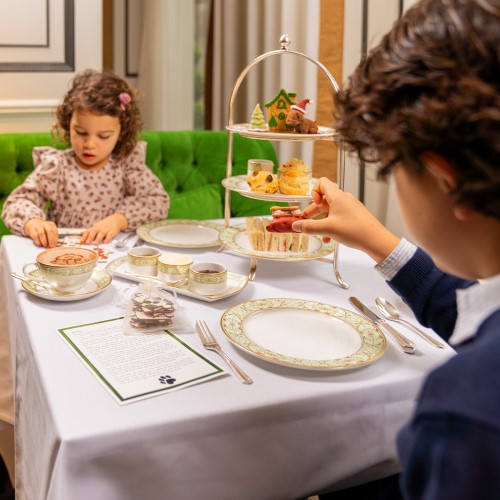From stilton and plum puddings to parties on ice, we explore the foodie festive history of Mayfair and St James’s
Words: Alice Cairns
Christmas is a time for tradition, and our local shops, businesses and hotels are no exception. Christmas merrymakers have been visiting Mayfair and St James’s for centuries, whether to source materials for a festive fondue or to take a turn on an ultra-glamorous indoor ice rink.
Paxton & Whitfield of 93 Jermyn Street has a special part to play in the history of Christmas dinners. The historic cheesemonger was one of the first to bring stilton to the UK market, selling an average of 2,000 stiltons between October and December throughout the 1910s (until the outbreak of war and rationing put a stop to this roaring trade). Today, stilton remains one of the shop’s best-selling cheeses, and never more so than during the festive season.
A less traditional use for cheese gained popularity in the 1960s, when a craze for fondue swept the nation. Customers at Paxton & Whitfield would buy blocks of cheese to melt into a gooey winter warmer, to be eaten with crusty bread, veg, fruit and meats at celebration dinners.
One customer reminisces: “Using two fondue pots and burners I once managed to produce fondue for a party of 12 people, but six was a more apt number. For that [Paxton & Whitfield] would sell me a pound of gruyère, a pound of Emmentaler and a quarter of a pound of appenzeller. I would load myself with bottles of Fendant du Valais from a shop in Old Compton Street for which I think I paid 13 shillings (65p) each. In retrospect, 55 years on, I suppose that fondue may not be very suitable for an evening meal – but we didn’t seem to mind…”

For a more traditional Christmas spread, the Fortnum & Mason food hall remains synonymous with festive feasting. On Christmas Day in 1845, Charles Dickens described Fortnum’s in The Morning Chronicle as “a perfect fairy palace, and Prince Prettyman paradise of bonbons, and French plums, and barley sugar”. Crammed with sweets, nuts, preserves and exotic fruits, it was the festive destination of choice for well-to-do Victorians.
Fortnum’s has been producing its iconic champers since the 1730s, supplying them to soldiers in the trenches, Suffragettes in prison and mountaineers on Everest. They’ve become a seasonal staple, with the Fortnum & Mason Christmas catalogue from 1910 stating that:
“Of Xmas gifts
The most seasonable
Always acceptable
The best of everything
And most appreciated
Is a hamper from Fortnum & Mason’s.”
In 1910, the cheapest option was the Guinea Hamper, which included cured ham, a plum pudding, a jar of mincemeat, a tin of sardines, stem ginger in syrup and a box of plums. The most expensive hamper, which cost 10 Guineas, included six bottles of champagne and six bottles of 40-year-old port, as well as meats, fine chocolates, bottles of liqueurs, a plum pudding and a single fresh pineapple.
For those who preferred to enjoy their Christmas meal in a restaurant, nowhere was more luxurious than Claridge’s. In 1922, the Pall Mall Gazette describes how the foyer of the hotel was to be transformed into a Watteau temple to mark the festive season:
“Thousands of tiny silver ivy leaves will cover the classic columns and drape the ceilings, which will be as a wonderful blue sky with a myriad of tiny white lights. Every table will have its special Christmas tree. The Maître Pagot, head chef of Claridge’s, is preparing special and unique dishes for the great occasion.” A typical Christmas menu from the 1930s was composed entirely in French, and included oysters, lobster Newberg, chestnut timbale, Christmas pudding and ice cream.
Guests would be entertained as they ate by an orchestra or dance band, which would perform a festive programme of seasonal music.

When it came to dancing, the bright young things of Mayfair could be found in the Great Room at Grosvenor House, which housed an enormous indoor ice rink (it was here that the seven-year-old Queen Elizabeth II learned to skate in 1933). At Christmas, the rink became a venue for fantastical ice galas and balls, with guests arriving in costume to dine, drink and skate the night away. The popularity of these ice balls eventually gave designer and developer AO Edwards the idea to transform the Great Room into a banqueting space, a hub of London society where debutantes were presented to the Queen until 1958.
But Christmas wasn’t all about luxury. According to Philip Sykes, founder and principal of The British School of Excellence based at 8 Shepherd Market: “Even amongst the wealthy, presents and cards were often hand-made. A lot of skill and thought went into gift giving between family members.
Sending Christmas cards was an incredibly important ritual – people would sit down in November and compile a list of recipients near and far. “Then, as now, the most important parts of the Christmas ritual involved taking time to think about your loved ones. That’s the real spirit of Christmas, after all!”
3 ideas for festive tea

FESTIVE CHEER
Lean into winter with a festive tea at the Montagu Kitchen and Lounge at The Churchill London. Signature pastries are paired with tea blend ‘Roses in Bloom’ with delicacies like buttermilk and blueberry bauble and black forest Stollen cake.
Thu-Sun; Dec 1 to 30, from £46

CHILD’S PLAY
The Park Room at JW Marriott Grosvenor House London is introducing a festive tea for children. Junior diners will receive a letter from the hotel mascot and a selection of sandwiches and sweet treats with a cup of hot chocolate.
parkroom.co.uk

TALE WITH A TWIST
This Christmas, The Dilly’s Peter Rabbit afternoon tea brings to life the classic story by London author Beatrix Potter, with a festive twist for children and adults alike. The tea features treats including an edible Santa hat.
21 Piccadilly







